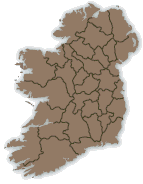Tiocfaidh an samhradh (cuid 2) - Áine Ní Mhuireadhaigh
Recording: [Download audio file]
[Download AIFF audio file (of processed ‘user’ version)]
[Download AIFF audio file (of archive version)]
Transcript
Shiúil mé thoir agus shiúil mé thiar,
Shiúil mé Corcaigh agus sráid Bhaile Átha Cliath,
Shiúil mé an baile seo le dhó[1] le bliain,
Ag iarraidh mo stóirín a bhain daom mo chiall.
Translation
I walked east and I walked west,
I walked Cork and the streets of Dublin,
I walked this village twice within this year,
Looking for my darling who drove me mad.
Commentary
Parts 1 and 2 of this recording comprise a version of what is a very popular song in Donegal. It was also popular in Omeath when Irish was the vernacular language of the area. There are several different versions which generally tell the story of a man, often a sailor, who loses his lover to another man. The last two verses in part 1 are closely related to Mánus Ó Creag's version of 'An Táilliúir Aerach' which can be found elsewhere in the Doegen collection. The whole melody is structured as follows: first phrase, second phrase, second phrase, first phrase. Each phrase consists of four bars. This is often referred to as ABBA form. Quatrain verses are easily set to such melodies and this structure is very popular in the Irish song tradition. Lorcán Ó Muireadhaigh published an eight-verse version with tonic solfa in Amhráin Chúige Uladh (Dundalk, 1927), no. 32. For staff notation of the melody, an alternative version of the song collected in Gaoth Dobhair, county Donegal, and additional bibliographic notes, see Colm Ó Baoill, Amhráin Chúige Uladh (Indreabhán, 2009), 85-6, 159, 185. A five-verse version of this song appears in Liam Ó Conchubhair and Derek Bell, Traditional songs of the north of Ireland (Dublin, 1999), 111-12. The melody closely relates to that sung on the present recording. Other songs set to the same melody include: 'The summer is come and the grass is green' (see P.W. Joyce, Ancient Irish music (Dublin, 1873), 19) and 'Rich and rare were the gems she wore', composed by Thomas Moore (see Charles Villiers Stanford, Irish melodies of Thomas Moore (London, 1894), 18). Another six verses (i.e. part 1) of this song can be found on a separate track in the Doegen collection.
Title in English: Summer will come (part 2)
Digital version published by: Doegen Records Web Project, Royal Irish Academy
Description of the Recording:
Speaker:
Áine
Ní Mhuireadhaigh from Co.
Donegal
Person who made the recording:
Karl Tempel
Organizer and administrator of the recording scheme: The Royal Irish Academy
In collaboration with: Lautabteilung, Preußische Staatsbibliothek (now Lautarchiv,
Humboldt-Universität zu Berlin)
Recorded on 30-09-1931 at 12:30:00 in
Courthouse, Letterkenny. Recorded on 30-09-1931 at 12:30:00 in
Courthouse, Letterkenny.
Archive recording (ID LA_1238d2, from a shellac disk stored at the
Royal Irish Academy) is 00:30 minutes
long. Archive recording (ID LA_1238d2, from a shellac disk stored at the
Royal Irish Academy) is 00:30 minutes
long.
Second archive recording (ID LA_1238b2, from a shellac disc stored in
Belfast) is 00:30 minutes long. Second archive recording (ID LA_1238b2, from a shellac disc stored in
Belfast) is 00:30 minutes long.
User recording (ID LA_1238d2, from a shellac disk stored at the Royal
Irish Academy) is 00:29 minutes long. User recording (ID LA_1238d2, from a shellac disk stored at the Royal
Irish Academy) is 00:29 minutes long.





